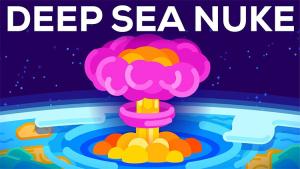What if detonated humanity’s most powerful nuclear weapon in the deepest part of the ocean?
Currently, the deepest point on Earth is located in the Mariana Trench. The Mariana Trench is a very deep valley, located at the intersection of two tectonic plates and looks like an upside down mountain. This trench has a depth of up to 11km, nearly three times deeper than where the Titanic sank.
This is one of the last places on Earth that humans have not explored. With no light and a pressure of 1000 times that of the atmosphere, the Mariana Trench is a fairly well preserved environment untouched by man, a great place to test nuclear weapons.
We will use the largest nuclear bomb ever detonated, the hydrogen bomb RDS-220, also known as the Tsar Bomba . With such destructive power that its shock wave circled the Earth three times and the mushroom cloud it created stretched 56km across the sky.

These bombs emit so much energy that they can vaporize an entire lake.
The bomb’s shock wave was strong enough to destroy everything in an area of 1000km 2 . Its fireball was hot enough to melt the rubble.
These bombs emit so much energy that they can vaporize an entire lake. If we detonate the bomb at the Mariana Trench, that’s bound to happen.
Let’s press the detonation button.
In the first few milliseconds, the atomic material will start a chain reaction and explode with the energy equivalent of 50 million tons of TNT.
For the first time in history, the maximum beam of light will spread across the trench. The heat from the explosion that created the void was a flaming bubble filled with water vapor , radioactive elements, and the remains of unlucky fish.
The bubble gets bigger and bigger as it evaporates the surrounding water. The pressure of the bubble was so great, that it continuously expanded but had nothing to stop it, creating a seismic shock that could be detected by measuring points and whales around the world. The vibration will disappear as quickly as it appears.
On the Earth’s surface, this fireball can be as wide as 10km after exploding 1 second under the weak resistance of the atmosphere. But the pressure at the bottom of the Mariana Trench is enormous. With 11km of water overhead, the pressure in the Mariana Trench is like being crushed by a hydraulic press from all sides.
One second after detonating, the balloon was only 1km in diameter. Then it started to shrink. The bubble is over-inflated, losing pressure until its juices shrink.
The deadly fireball and seawater interacted several times, the bubble shrinking and expanding until it couldn’t hold back the seawater. The ambient pressure was too great and the seawater began to split it. It turns into something similar to a mushroom cloud, but underwater. It dissolves into smaller, hot and radioactive bubbles that drift upward.

The aftershock of the explosion also reached the surface, but it did no harm.
The aftershock of the explosion also reached the surface, but it did no harm. It was just a small wave, a radioactive bubble over the Pacific Ocean.
No tsunami has ravaged Japan or California, but ships and whales in the area may not be as happy.
The remnants of radioactive material will dissolve into the Pacific Ocean within a few days, but most of the radioactive material and salt will ascend to the atmosphere, where it will condense and rain down.
As soon as the wind blows these substances directly to the Philippines, the rain probably pours into the ocean. The danger lies in the fact that the explosion can lead to earthquakes and volcanoes.
Although detonating the bomb where two geological plates intersect, disaster is very unlikely. The explosion would vaporize part of the seafloor, turning much of the sand into glass, but most of the energy produced would go into the water, not creating seismic events.
Did the explosion affect Earth’s orbit? Since no mass is lost or added, Earth’s orbit will remain unchanged.

